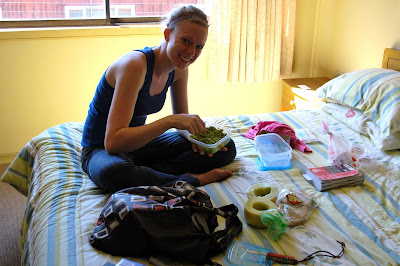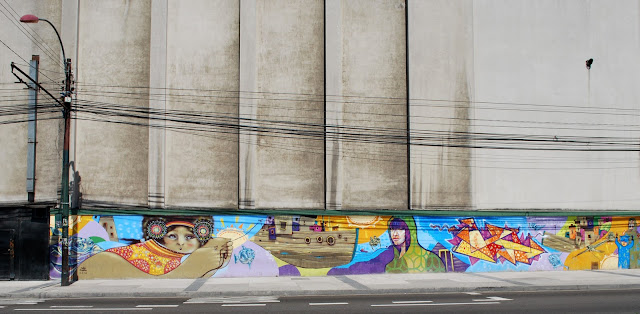Bariloche, the largest city in the Argentinian side of the Lake District, is a pretty city with lots of european influence (mostly German) on the edge of Lago Nahuel Huapi, a glacial relic over 100km long. The main hostel street, Salta, is up on the hill behind the downtown and has fantastic views of the lake. We stayed at TangoInn Downtown, and other than the excessively creaky bunkbeds and blasting heat, found it very comfortable. They even had a on-site masseuse, and we obviously took advantage of the 90-minute hot-stone massages for $20 (!) to ease our aching backs (our packs aren't getting any lighter, as you can probably imagine).
 |
| The view from the 4th floor of Hostel TangoInn |


We spent a day wandering around Bariloche, enjoying the sights. The city is over-run with chocolate shops, although they really haven't figured out the dark-chocolate thing in South America yet, so it wasn't as dangerous as it could have been (we are both dark-chocolate lovers).
Monday the 22nd of November was a national holiday in Argentina, so we took advantage of that fact and rented a car, since it meant we could pick it up the night before, and not return it until the morning after the holiday. We flipped a coin to see who had to drive first (out of downtown) and Alex lost (or won?) and got to drive first.
 |
| Our Volkswagon "Gol" (no, not a "Golf") |
Dealing with the un-marked intersections was a steep learning curve, but we got a hang of it fairly quickly. Few road rules are actually obeyed in Argentina, but it seemed a significantly safer than other parts of South America we've visited. By the end of the day we'd determined that the rules at unmarked intersections are as follows; 1) taxis and large trucks will not slow down, so give them the right of way, 2) slow down as you approach an intersection, but don't stop unnecessarily or you risk getting rear-ended and 3) stay confident, and don't second guess. We got an early start the next morning and headed first for Cerro Campanario for a short morning hike to see some of the "best views in the world" (according to our hostel-hostess).
You could have taken a chairlift up (unfortunately, that meant it was a bit crowded at the top) but the hike was refreshing, and we saw wonderful flora along the way.
After Cerro Campanario, we continued along the Circuito Chico (the famous 60-km loop road around Lago P. Moreno), stopping along the way to take a single-track dirt road out to the remote Villa Tacul beach for a snack and some great views.
The yellow bushes you see below were in full bloom and lined both sides of the road all day.
After completing the Circuito Chico we headed south to Cerro Catedral, one of the biggest ski centers in South America. The base of the hill was crowded even though ski season had already ended. We had a picnic-lunch on a deserted beach along the way, and enjoyed some local treats from the grocery store (deer salami, mushroom tapenade, and whole-wheat buns). Afterwards, we continued south along Ruta 40 to El Bolsón. We arrived in the late afternoon and wandered around, ate some gelato, and visited a trout farm. The trout farm was suprisingly lovely, and we chatted with the owner and sampled smoked trout and homemade jams. You could walk around the ponds, which housed trout at various life-stages (juveniles, "small", "large"). We bought an entire smoked trout (two filets) for about $5 CDN for a picnic the next day.
 |
| "No tocar las truchas" = "Don't touch the trout" |
 |
| One of the trout ponds |
We headed back to Bariloche in the late evening after a satisfying day of exploring .
We spent a 4th (and final) day in Bariloche doing errands. After hanging on by a thread for the past month and a half, the zipper on Alex's day-pack finally broke completely, and Lisa's day-pack really shouldn't have come on this trip at all. Bariloche is a major outdoor-sports center and as a result had a good selection of outdoor equipment stores. Lisa bought a new day pack, and Alex amazingly found someone to replace the zipper on her pack, the same day, for ~$12 CDN! The following morning we took the 7:30 bus back to Chile, destination: Puerto Montt. The Chilean border crossings are by far the most hassle in South America. Efficiency isn't high here, but it's like they are trying to acheive US border-control standard with fewer resources. For reasons unknown, the bus drive had us line up alphabetically to go through immigration, which was hilarious because 1) he was attempting to read a list of mostly Korean last names with a heavy chilean accent (fail) and 2) "Bahlsen" was first on the list to get called before anyone really knew what was going on. Chile is the only country which cares what you have in your bags (nowhere else even asks, never mind looks), and they scan them for fresh food, and impose heavy fines if you don't declare your goods.
We got into Puerto Montt later than planned, and checked into a kitchen-less hotel, since Puerto-Montt hasn't really hit backpacker-radar yet, and is lacking hostels. In an effort to pinch a few pennies, since eating out here adds up, we made a picnic of guacamole (made in a tupperware container) and pita bread, with honeydew melon ("Melon tuna" in spanish) on the hotel bed.
We splurged (relatively, not by Canadian standards) on dinner and ate at the lovely El Balcon restaurant; an artsy cafe with lots of character serving twists on Chilean classics, like Humitas del Mar (Humitas topped with fresh crab meat and seafood) and fried Pejerrey (King fish) with real potatoes (the first time we've found un-deep-fried potatoes in South America!).
Today (all caught up!) we took a mini-bus to nearby Puerto Varas for some sight-seeing. Puerto Varas is famous for it's definitely "German-ness". Much of Southern Chile has a distictly German feel, thanks to selective immigration policies imposed in the late 1840's (you can read more about it here). The city is located on the edge of Llanquihue Lake, and nearby Osorno Volcano.
We ate lunch at the wonderful Caffe el Barista downtown. We enjoyed some un-rivaled (on this trip anyways) paninis (smoked salmon/avocado/cream cheese, and marinated chicken/arugula/olives/cheese) and perfect coffee and tea. We liked the restaurants slogan (below) which means "Only the best coffee: black like the devil, hot like an inferno, pure like an angel and sweet like love".
One of the most famous landmarks in Puerto Varas is Iglesia del Sagrado Corazon, a church based on the Marienkirche church of Black Forest, Germany.
We jumped on a mini-bus back to Puerto Montt in the afternoon and stocked up on extra fruit, vegetables and reserva wine (because why not drink Reserva's when they cost $5?) for our upcoming boat journey to Puerto Natales. We embark tomorrow morning, and will travel non-stop through the Patagonian Fjords, down the coast of Chile, for the next 4 days. We aren't entirely sure what to expect, but are extremely excited for this next leg of our adventure. We have tickets for cheap-bottom-of-the-boat bunks, aboard the 200-passenger Navimag cargo/passenger-ferry. We won't have internet (obviously) for the next 4 days, and may jump right into some trekking upon arrival in Puerto Natales, so don't worry if you don't hear from us for the next week! (We'll be safe, we promise).





























































